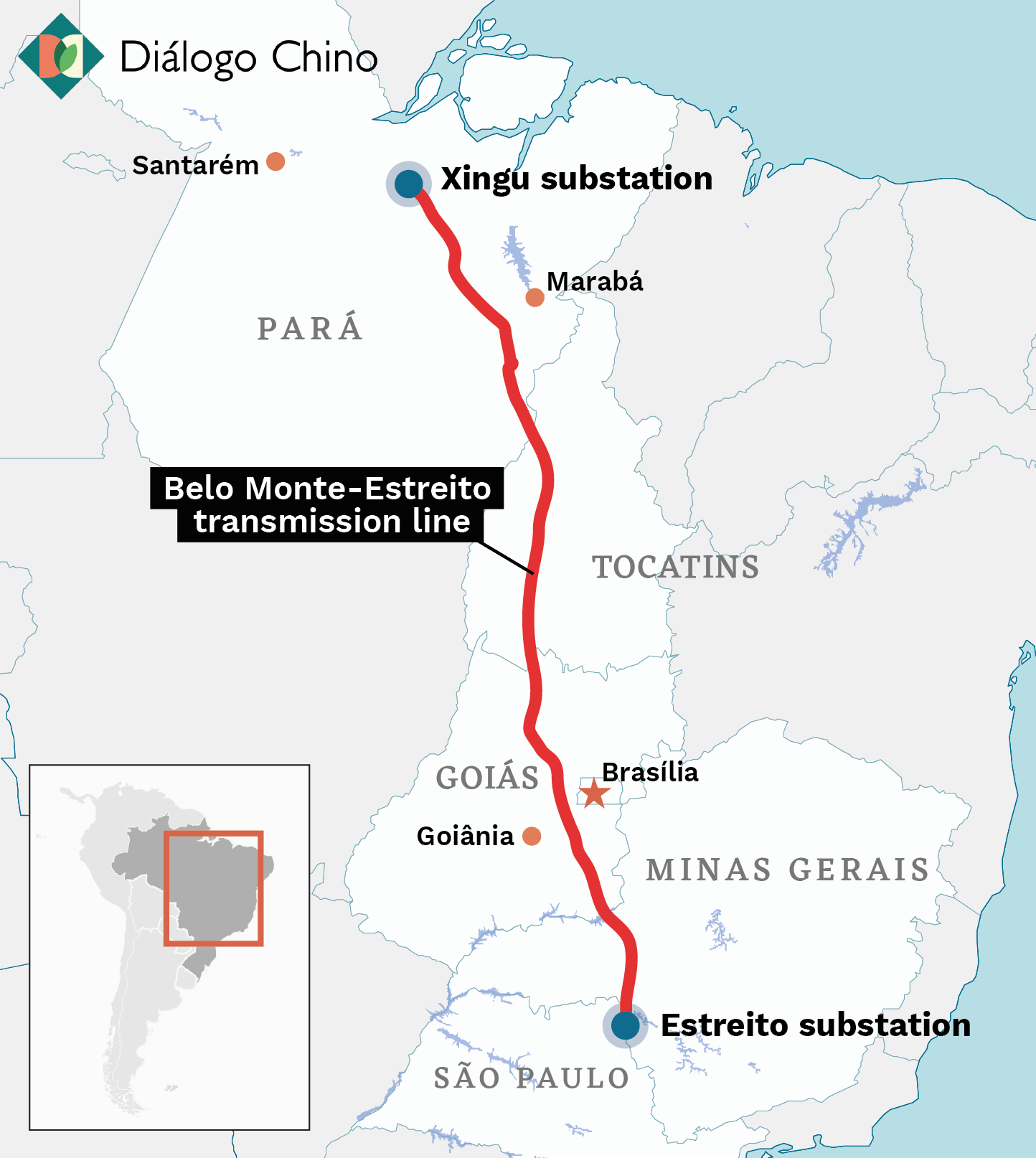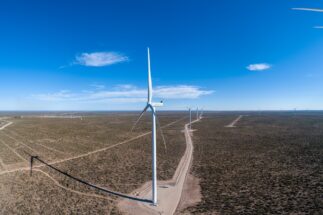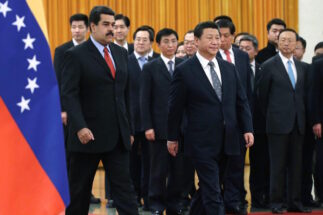Mining companies want to explore areas of Brazil’s Pará state underneath the giant Amazon-bisecting transmission line known as the linhão, or ‘big line’, that distributes electricity from the Belo Monte hydropower plant to the southeast of Brazil.
Diálogo Chino found 100 requests to the National Mining Agency (ANM) from mining companies and cooperatives for the right to research and mine the Pará axis of the Xingu–Estreito network. Of these, 37 were denied because they overlapped with the electricity distribution network but another 63, which have the same problem, are still being processed.
If the projects go ahead, they could destabilise the terrain under the high-voltage towers and compromise the country’s energy supply.
“These requests are worrying,” says Luiz Pinguelli Rosa, professor of strategic planning at the Federal University of Rio de Janeiro’s engineering institute Coppe. “If a line like Xingu-Estreito goes down, we would probably have a blackout in several states.”

The 2,076-km network connects the Xingu substation in central Pará, passing through the states of Tocantins and Goiás, to the Estreito substation in Minas Gerais, on the border with São Paulo.
Inaugurated in 2017, the linhão, is controlled by Belo Monte Transmissora de Energia, majority owned by China’s State Grid in partnership with Brazil’s state-owned Eletrobras, which is soon to be privatised.
Chinese electricity giant State Grid, which has increased its presence in the Brazilian electricity sector, also operates the 2,539km Xingu–Rio line that connects Pará to the state of Rio de Janeiro.
Mining near the linhão: ‘An appearance of legality’
Threats to the linhão come as illegal mining threatens a vast portion of Brazil’s conservation areas. A recent report by the World Resource Institute showed that illegal mining impacts at least 37 indigenous lands in the country. There are hundreds of mining concessions overlapping at least in part with indigenous territories.
The 63 open applications to explore the area where the Belo Monte transmission line is located have begun being processed over the past year, and some were filed in 2020. On 17 August, for example, the Cooperativa dos Garimpeiros do Norte made three requests for gold extraction under the linhão between the municipalities of Anapu and Pacajá.
“When you make a mining application, the value for one or ten thousand hectares is the same, so we ask for a bigger area”, said Chester Pedro Gomes, president of the cooperative,.
“But when the study is carried out, the area that the ANM will approve will certainly be smaller,” Gomes said, adding; “Those who go after documents will never mine illegally.”
Brazilian mining giant Vale has already made six requests for mining along the network in Pará. One of them, for manganese research in Parauapebas, was initially rejected, but was eventually passed by the courts in 2018.
Mining or even asking for mining in energy areas is something serious
The company says it looks out for opportunities when it’s possible to reconcile its activity with that of other enterprises already installed in a given location. But it told Diálogo Chino that it “does not have operational activity” in the target areas of the six requests.
The ANM protects an area of 100 metres, 50 on either side of the transmission line, in order to prevent activities that threaten the stability of the energy network, such as mining. If mining activities are carried out in this region, they could seriously affect the linhão and, in an extreme situation, harm electricity distribution in vast areas of the country.
“The interconnected energy system could sustain supply at certain times,” says Rosa, the engineering professor, “but if it [a power outage] occurs in the late afternoon, when industries are still operating and there is high residential demand, there will be a blackout.”
ANM told Diálogo Chino that the reduced number of public servants in its office is delaying the evaluation of applications. But these requests near the linhão will eventually be rejected.
There are more than 200,000 mining requests across the country in the National Mining Agency system. Of these, 448 have been rejected or suspended for overlapping with energy networks. The agency stressed that the projects, as they stand on paper, do not harm the environment.
However, Pará’s Federal Public Prosecutor’s Office (MPF) takes a different view. The mere existence of the application, the agency warns, exposes the land to environmental risk.
Illegal miners engage in such requests to give “the appearance of legality to the activity,” MPF prosecution papers from November 2019 say. The lawsuit warns that this makes it easier to take over the extraction area, recruit personnel and hire services.
“Mining or even asking for mining in energy areas is something serious,” says Professor Pinguelli Rosa, “It is a policing problem.”
Illegal mining advances
While mining requests remain unresolved by ANM, illegal mining is already occupying the area under the transmission network in Pará.
Illegal miners have begun operating under the Xingu-Estreito line since at least 2019. And in July this year, the newspaper Estado de São Paulo showed that the Belo Monte Transmissora de Energia (BMTE) itself has made official complaints.
$815,000
the amount in fines that BMTE itself owes for deforesting or for non-compliance with the linhã's environmental permit
According to the report, BMTE says it is concerned about the safety of its employees and the degradation of the soil near the linhão, which could cause its towers to fall or sink.
The mining agency is aware of the illegal activity and works with relevant bodies to curb it in the region. The complaints have been investigated by Pará’s MPF and the Federal Police.
On 23 August, the corporation seized 70,000 tonnes of manganese in the port of Barcarena, Pará. The ore was allegedly mined illegally in the south of the state, part of it in illegal mines near the Xingu-Estreito line, according to ANM.
BMTE did not comment on the ongoing mining processes, but confirmed to Diálogo Chino that it had communicated illegal mining on the Xingu-Estreito line to inspectors.
The company, which is today the victim of activity that brings environmental risks and threatens its R$5.6 billion (US$1 billion) enterprise that has already caused controversy.
In its 2016 environmental impact report, the group estimated that construction of the linhão would cause the deforestation of an area of native vegetation in the Amazon and Cerrado biomes equivalent to more than 1,700 football fields.
At the time, the Xingu-Estreito’s environmental impact studies were approved three months quicker than the average of nine-month timeframe, and, unusually, with the government making no additional demands, according to a coordinator at federal environmental protection agency IBAMA.
There is no information on how much native vegetation was actually cut down, but between March 2017 and September 2018, BMTE received seven fines from the environmental inspection agency.
The company owes a total of R$4.5 million (US$813,000) for crimes such as deforestation in a preservation area and non-compliance with environmental permit conditions.







![A snow leopard in Uttarakhand [image by: Sonu Negi]](https://dialogue.earth/content/uploads/2020/10/Featured_image_PIC_credit_Sonu_Negi_1-300x200.jpg)

